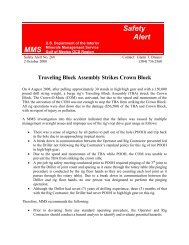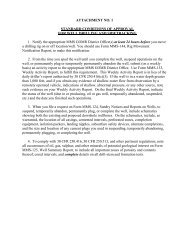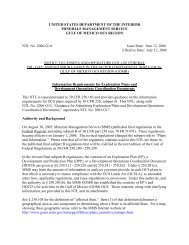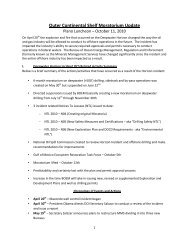Deepwater Gulf of Mexico 2004: America's Expanding ... - OCS BBS
Deepwater Gulf of Mexico 2004: America's Expanding ... - OCS BBS
Deepwater Gulf of Mexico 2004: America's Expanding ... - OCS BBS
- No tags were found...
You also want an ePaper? Increase the reach of your titles
YUMPU automatically turns print PDFs into web optimized ePapers that Google loves.
production and about 50 percent <strong>of</strong> deepwater gas production. Figure 63a shows that very little<br />
deepwater oil production came from subsea completions until mid-1995, but by the fall <strong>of</strong> 1996 that<br />
production had risen to about 20 percent. Since 2000, subsea oil production has increased slightly,<br />
whereas total deepwater oil production has increased dramatically. <strong>Deepwater</strong> gas production from<br />
subsea completions began in early 1993, and by mid-1994 they accounted for over 40 percent <strong>of</strong><br />
deepwater GOM gas production (Figure 63b). Gas production from subsea completions increased<br />
from 1996 through 1999, remained constant in 2000, and increased rapidly after 2000.<br />
COMPANIES AND PRODUCTION<br />
<strong>Deepwater</strong> oil and gas production was confined almost entirely to major oil and gas companies<br />
through 1996 (figures 64a-b). (Production volumes in figures 64a-b, 65a-b, and 66a-b are attributed<br />
to companies on the basis <strong>of</strong> their percentage <strong>of</strong> lease ownership. For example, if Shell owned<br />
75 percent <strong>of</strong> a particular lease in July 1997, then 75 percent <strong>of</strong> that lease’s production was attributed<br />
to Shell that month.) In 1998 and 1999, nonmajor companies significantly increased their deepwater<br />
oil production (figure 64a). However, since 2000, nonmajor oil production has leveled <strong>of</strong>f while<br />
major oil companies continued their steep increases in oil production. Gas production from<br />
nonmajor and major companies has increased at approximately the same rate (figure 64b). Nonmajor<br />
companies currently own about 25 percent <strong>of</strong> deepwater GOM oil production and 30 percent <strong>of</strong> gas<br />
production.<br />
In shallow water, nonmajor companies now produce more oil than the majors (figure 65a). In<br />
addition, nonmajor gas production represents an increasingly greater share <strong>of</strong> the total shallow-water<br />
gas production (figure 65b). This confirms the speculation that majors have been concentrating more<br />
in deepwater for their production needs.<br />
Figures 66a and 66b display production contributions from each major oil and gas company. Shell<br />
and BP were the driving forces behind increasing deepwater production, with Shell as the clear<br />
leader in both oil and gas production. Shell’s dominance in deepwater oil production began before<br />
1992 and its recent increases have outpaced those <strong>of</strong> the other major companies. Shell also led in<br />
deepwater gas production, including a dramatic increase in 1997. BP oil production increased<br />
significantly since 1998 (in part because Shell and BP have joint ownership in several large<br />
deepwater fields). BP is second in terms <strong>of</strong> gas production because <strong>of</strong> steep increases in deepwater<br />
gas production since the last report. Note that BP has several significant projects on the horizon<br />
(e.g., Mad Dog, Thunder Horse, and Atlantis) that will contribute significantly to its oil and gas<br />
production totals.<br />
PRODUCTION RATES<br />
High well production rates have been a driving force behind the success <strong>of</strong> deepwater operations.<br />
Figure 67a illustrates the highest deepwater oil production rates (monthly production divided by<br />
actual production days). For example, a well within Shell’s Bullwinkle field produced about<br />
5,000 BOPD in 1992. In 1994, a well within Shell’s Auger field set a record, producing about<br />
10,000 BOPD. From 1994 through mid-1999, maximum deepwater oil production rates continued to<br />
climb, especially in water depths between 1,500 and 4,999 ft (457 and 1,524 m). Horn Mountain<br />
came on line in early 2002 in 5,400 ft (1,646 m) water depth with a single well maximum rate <strong>of</strong><br />
more than 30,000 BOPD. The deepest production is currently held by Camden Hills in 7,216 ft<br />
(2,199 m) water depth.<br />
Figure 67b shows maximum production rates for gas. These rates hovered around 25 MMCFPD<br />
until a well in Shell’s Popeye field raised the deepwater production record to over 100 MMCFPD in<br />
1996. Since then, the deepwater has yielded even higher maximum production rates. In 1997,<br />
Shell’s Mensa field (5,379 ft [1,640 m] water depth) showed the excellent potential for deepwater<br />
production rates beyond the 5,000 ft (1,524 m) water depth. The record daily oil and gas production<br />
rates (for a single well) are 41,532 BOPD (Troika) and 145 MMCFPD (Mica).<br />
90







